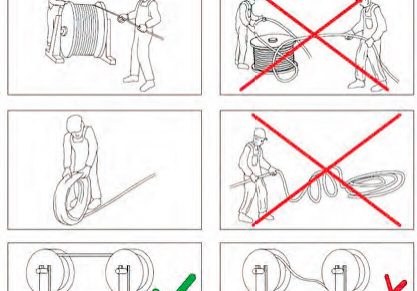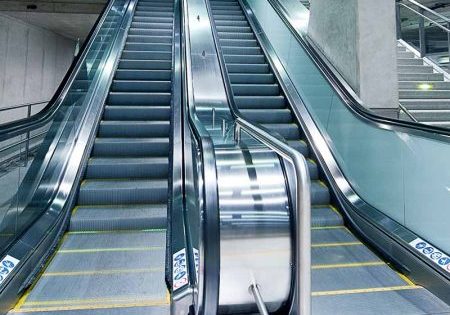ISO/TC 178 chairman discusses the “United Nations of standardization” publication of ISO 8100-32:2020.
The International Organization for Standardization (ISO), after a six-year, intensive international effort, has published ISO 8100, Lifts for the transportation of persons and goods, Part 32, a completely new standard for the “planning and selection of passenger lifts to be installed in office, hotel and residential buildings.” With its publication in June 2020, ISO 8100-32:2020, Planning and selection of passenger lifts to be installed in office, hotel and residential buildings will begin to be applied step-by-step to the elevator industry, as well as demands by customers that the new standard be met.
In September 2020, your author (USB) talked with Gero Gschwendtner (GG), chairman of ISO/TC 178 and responsible for the ISO Technical Committee, which developed this standard via a focused working group (WG). Gschwendtner is based in Vienna, Austria, and currently focuses on his mandates within ISO/CEN. He stresses the importance of promoting the standard, as its acceptance will guarantee uniform procedure all over the world, thus shaping the future of the overall elevator industry.
According to Gschwendtner, the ISO WG included experts from major elevator companies, renowned academics and elevator consultants (e.g., from Israel, Germany, the U.S. and the U.K.) with known expertise in elevator traffic analysis and elevator code. In the beginning, 17 people were nominated from the national standards bodies; in the last meeting, 14 of them representing eight countries took part.
USB: Which forerunners in elevator planning standardization existed before the new ISO standard?
GG: ISO 4190-6:1984, on elevator selection in residential buildings, was in use in the industry. It helped to determine the appropriate number, rated load and speed of the elevators. The methods relied on probability models. Conventional control — as described in the standard — operates such that passengers select a direction from the elevator lobby and enter their specific floor destination after boarding the elevator car. But, the latest control systems and simulation were both missing. And the standard dealt only with residential use. Thus, it saw less use in recent years.
USB: What is the relation of ISO 8100-32 to EN 81-20/-50?
GG: EN 81-20/-50 is dedicated to safety for construction and installation, whereas ISO 8100-32 is dedicated to traffic planning.
USB: And then there was also the migration of the ISO number series.
GG: For easier use, the ISO standard series for lifts, escalators and moving walks (e.g., ISO 4190, ISO 7465, ISO 18738) is now migrated to the new numbering ISO series 8100, which was luckily available. The new ISO structure is similar to the CEN system, as even China is aware of the EN 81 numbering. When an old ISO standard is revised, it will be converted to the new number. The old number will be kept until the next revision. Several numbers will not be transferred at all (if no further revision will be carried out). They are too widely used and/or are indicated in national regulations (e.g., ISO 14798 Risk Assessment or ISO 25745 Energy Performance).
USB: There has also been a “political” discussion whether to adapt EN 81-20/-50 as ISO 8100 parts.
GG: EN 81-20/-50 is accepted practically everywhere – except in the U.S. and Japan. Thus, it was a logical decision to take over EN 81-20/-50 and publish it as ISO 8100-1/-2. This was agreed within the ISO voting process by all member states. All regional lift associations support the development of ISO standards, which is captured in the Global Technical Barrier-Free Trade agreement. The contents of ISO 8100-32 did not yet exist as a CEN standard. So, in this case, there would have been no problem anyway. Due to the change of the ISO standards numbering scheme, it was converted from ISO 4190-6 to ISO 8100-32.
USB: Who came up with the idea for this standard?
GG: All standards must be reviewed every five years. They are sent to all standards bodies for comments. These were then passed to WG 6 of ISO TC 178. Also, several manufacturers made an analysis with their own criteria, finding that no appropriate standard was available. Then, in 2013, at the 25th plenary meeting in NYC, ISO TC 178 decided to update the standard. The first meeting took place on April 15, 2014. The WG had several face-to-face meetings, generally twice per year. In total, about 50 meetings — mostly via video — were held.
USB: Were there any major contributions to the contents?
GG: All members cooperated to create the new standard.
They made their contributions covering their different viewpoints. Marja-Liisa Siikonen, convener of ISO TC 178 WG 6/SG 5 and representing the Finnish Standards Association, invited everybody to the meetings, made the organizational arrangements and wrote the agenda. She chaired the meetings, kept them on schedule and coordinated information between WG 6 and SG 5. The participants edited the standard from scratch together online. It was a common effort, and they reviewed the texts sentence by sentence. They received many comments from the ISO TC 178 member countries within the ballots and revised the text accordingly, too. The final standard was approved by the final voting of the national bodies within ISO before publication.
USB: Was there a special trigger leading to the new standard?
GG: The terminology, analysis methods and design criteria should be updated to the state of the art. Office buildings and hotels should be included, along with residential buildings. Destination control systems should be considered, in addition to conventional collective control systems. A simulation method, in addition to a calculation method, should be provided.
USB: What are the objectives of the new standard?
GG: As the title of the standards states, its objective is to reduce difficulties in comparing elevator analyses provided by different manufacturers and consulting firms. The methods should be easy to understand for all involved. As a help, additional descriptions and selection charts are given in the annex. We provided the theory and made sure it can be used immediately. We deliver the knowledge to customers and to small and medium-sized enterprises (SME), too. By this means, we also fulfill our objective of knowledge transfer. Both objectives contribute to reach the third objective: making sure that the vertical-transportation (VT) system fulfills the expectation.
USB: Can you please give a more precise description of the contents of the new standard?
GG: The paper details methods of evaluating potential elevator performance in a given building to determine the number, size and other characteristics of an appropriate elevator system. It also gives exact definitions for specific elevator terms to promote consistency between elevator practitioners.
USB: Let’s follow the flowchart “Design Process” in Figure 1, which was adapted from ISO 8100-32:2020 Annex F.
GG: “Collect building data” stands at the very beginning of the design process. Generally, you get these data from the customers. Concerning the building data, people rely on the architectural drawings, but these data can change significantly even after one month. It is always important to work with the latest data, even if the design process stretches over, say, four years. The existing data must be revised regularly. In addition, several assumptions to be made will always remain. The differing outcomes on the different databases must be compared. There will be a best case and a worst case. According to the new standard, you should now work with the maximum occupation of the building. And, you have to think about the long-term usage of the building, too.
USB: What comes next in the process?
GG: Next, you “select method of traffic analysis.” Simulations deliver the most accurate results. In annexes B and C of the standard, you will find an initial elevator group estimation based on building height, number of floors and population. But the more complex the building is, the more often you end up applying simulation tools.
USB: How do you “select design criteria?”
GG: This is determined by the combination of the building-type information from the first step and the method of traffic analysis selected in the second step. In tall buildings, consultants generally specify the elevators. Different manufacturers apply the standard to their traffic analysis according to the consultants’ specification. The consultant compares the analyses to find the best product for the client.
USB: How does the process come to an end?
GG: The last step, “perform traffic analysis by selected method,” is followed by an iteration leading to the final result.
USB: Did you perform some tests in the WG?
GG: Yes. The group found that some simulations may lead to differences in results. The reason generally lies in different control systems of each manufacturer or the traffic simulation provider used in the traffic simulations.
USB: EN 8100-32 is the first modern standard on this topic. Will it be adopted by the whole industry? For example, will SMEs perform simulations?
GG: The standard includes selection charts for simple cases. Also, a calculation method is described. Concerning the use of simulations, the standard provides guidance. Not every company must have its own simulation tool. They could use software from somebody else. The standard helps with the application for more complex buildings. If a company provides, for example, destination-control software, it is generally available in the company’s simulation tool. Please keep in mind, if your elevator is faster than 7 m/s, you will need a simulation, but you are also outside the scope of the standard. Simulation nowadays is state of the art.
USB: What are the advantages by applying the standard, especially for customers?
GG: It provides a consistency of terminology, evaluation methods and recommended metrics among various providers. The customers of the manufacturers are consultants or building developers. Though the method is not completely new, the standard compiles the many existing experiences. It raises the customer’s faith that the installed elevator will fulfill its promises.
USB: And for the producers?
GG: It increases the certainty that the proposed elevator plan will meet the building’s needs.
USB: Do you have a message to ELEVATOR WORLD readers?GG: The ISO standard is now available and already being used globally, especially for high-rise systems in Asia. It is based on best practices and contains a lot of knowledge that can be used easily, thanks to the inclusion of examples and charts. It helps all stakeholders build a reliable VT system meeting all expectations. The standard is practical and useful. The state of the art is applied. Embrace it, use it!
For further information and to purchase the standard, visit bit.ly/2IJ39oc.
Position of Industrial Associations
Several associations offer their views of the new ISO 8100-32:2020, Planning and selection of passenger lifts to be installed in office, hotel and residential buildings.
Europe: European Federation for Elevator Small and Medium-Sized Enterprises
This standard is positive because it is appropriately written taking into account also the needs of those operators who, like small and medium-sized enterprises, are not always familiar with the calculations and the relevant necessary information that need to be considered to successfully make up a reasonable proposal to their would-be customers.
Europe: European Lift Association
ISO 8100-32 is the first modern standard for planning elevators that has been approved by many national standards organizations. It is replacing the old and outdated standard ISO 4190 Part 6 from 1984. It was prepared by experts from the industry, including notable consultants and the major elevator companies. The planning methods now consider — in addition to selection charts and calculations — a simulation based on full details for even complex buildings and mixed traffic. Simulation is the most beneficial planning method for customers and suppliers. The simulation method in ISO 8100-32 makes a separate simulation for each traffic mix (e.g., 40% incoming/40% outgoing/20% inter-floor) and passenger demand, uses constant traffic demand in each simulation and makes long simulations (to reduce variation of results). The commitment to facilitate dissemination of ISO standards worldwide was also reiterated (in April 2019) by 11 associations of the World Elevator Federation, which has become the World Elevator & Escalator Federation, to include escalators.
Austria: TÜV Austria Services
By the nature of things, for us, as an inspection and Notified Body, mainly dealing with the safety of lifts, this standard is of secondary importance. Nevertheless, it has to be said that this standard is a result of interesting discussions and considerations with a broad consensus. It provides a calculation method and a method for simulation of applications with a certain complexity: for example, buildings with a group of lifts equipped with destination control systems. Additionally, it provides selection tools, examples of calculations and diagrams for common applications in the annex. While the application of the standard will probably require a minimum level of experience, it is still fairly user-friendly. Last but not least, it makes systems comparable.
Germany: VDMA Elevators and Escalators (Aufzüge und Fahrtreppen)
DIN has approved the standard.
Switzerland: VSA (Association of Swiss Elevator Companies)
ISO 8100-32:2020 is the common reference for elevator companies and their customers when selecting lifts in buildings. This is useful for smaller and larger installations thanks to the various selection methods provided.
Get more of Elevator World. Sign up for our free e-newsletter.









